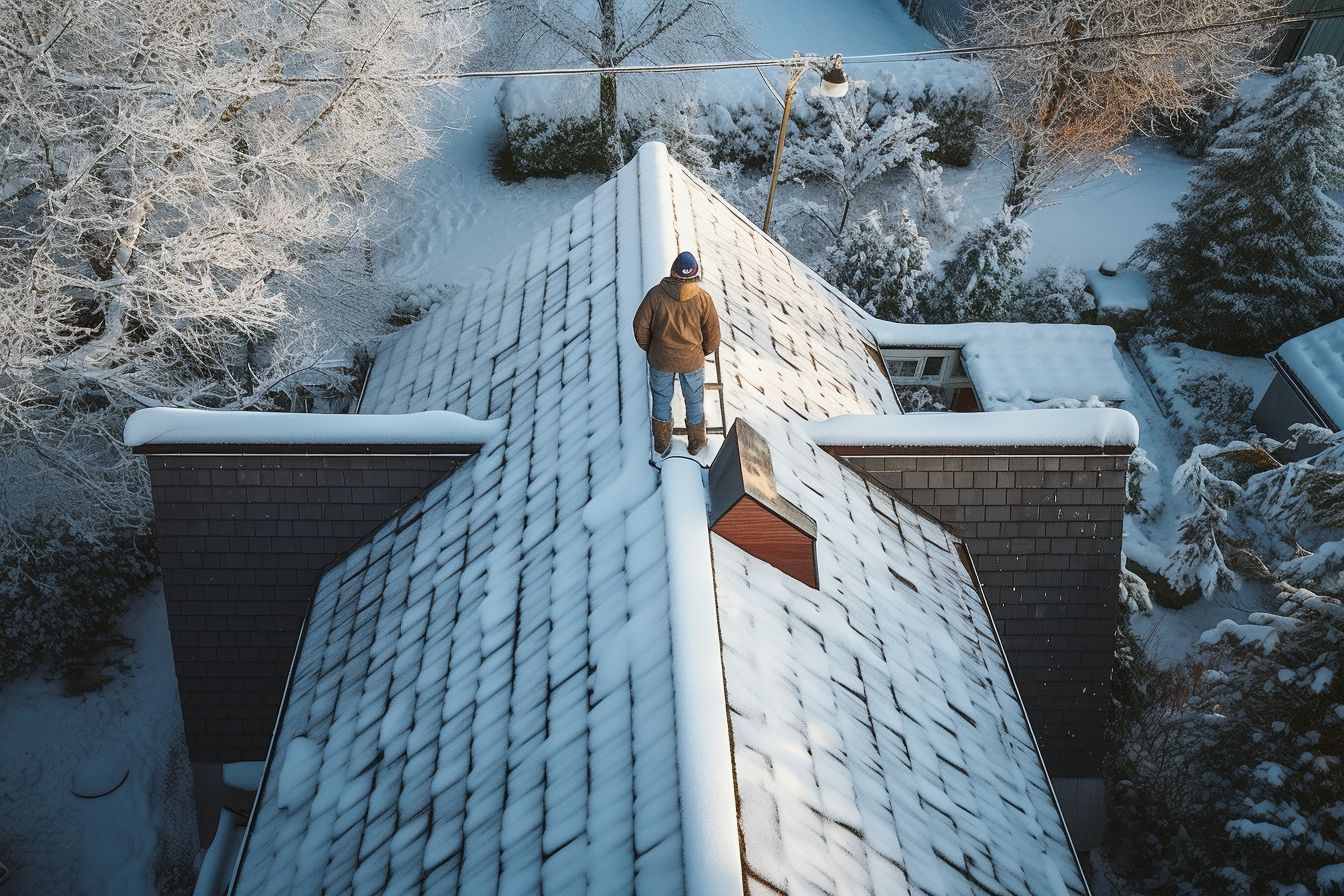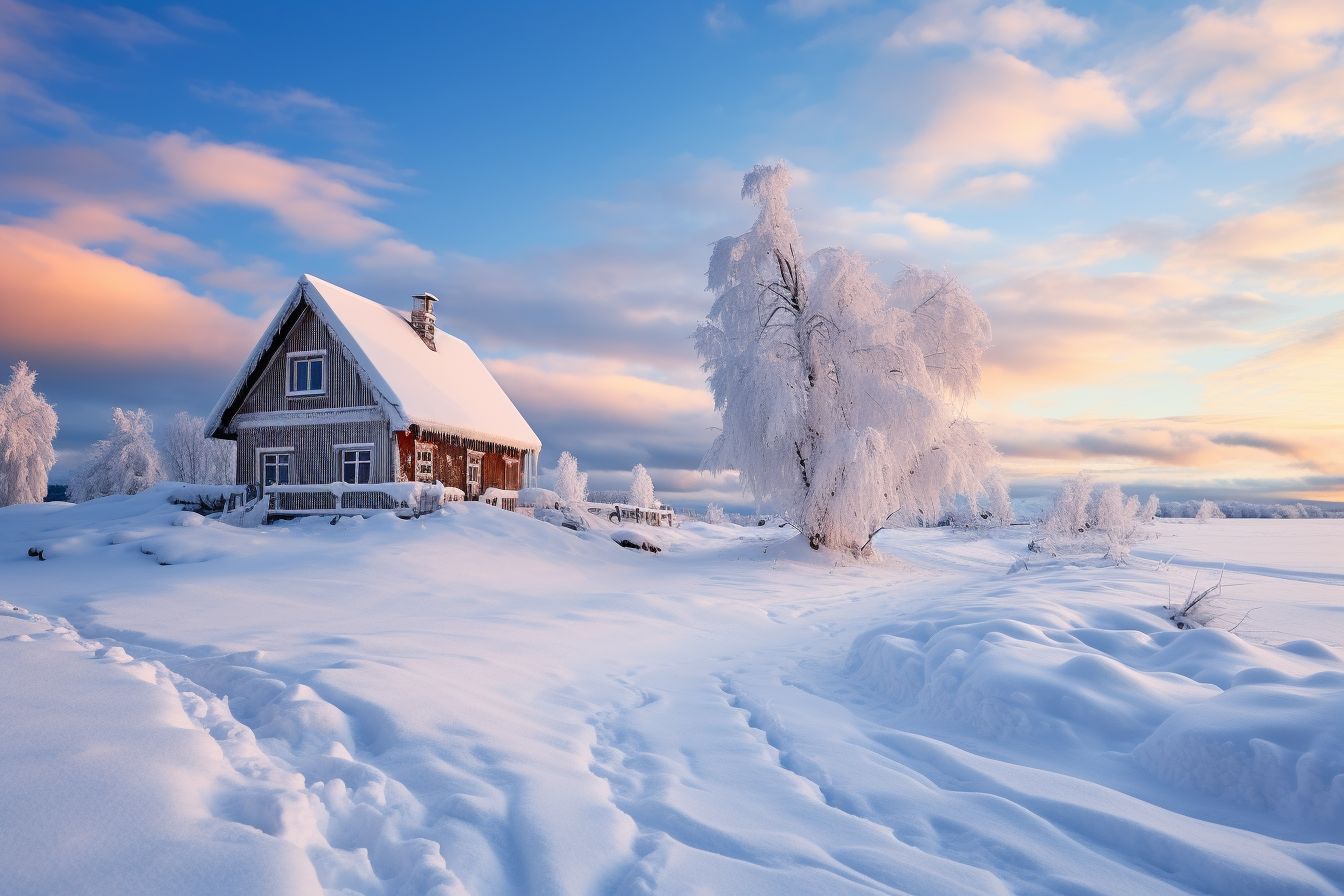Winter is coming, and with it, the risk of potential damage to your roof. Did you know that according to the National Roofing Contractors Association, winter weather is responsible for up to 30% of all roofing damages? This article will guide you through successful roof winterisation steps to protect your home from costly repairs.
Let’s dive into turning your rooftop into a winter fortress!
Key Takeaways
- Inspect your roof for damaged shingles, broken flashing, and old caulking that needs replacement to prevent major damages during winter.
- Clean gutters and downspouts regularly to ensure proper drainage and avoid ice dam buildup.
- Improve attic ventilation by installing roof vents, adding soffit vents, clearing obstructions, sealing gaps or cracks, and monitoring humidity levels.
- Add or upgrade insulation in your attic to improve energy efficiency, regulate temperature, prevent condensation, and extend the lifespan of your roof.
Tips for Winterizing Your Roof

Start the winterisation process by inspecting your roof thoroughly. Look for damaged shingles, broken flashing, and old caulking that needs replacement. Addressing these issues early can prevent major damage in the frosty season.
Cleaning gutters and downspouts are essential steps, too. Eliminating leaves debris and fixing leaks ensures proper drainage, avoiding ice dam build-up. Additionally, giving attention to your attic makes a vast difference! Amplifying ventilation reduces moisture; upgrading insulation boosts energy efficiency while preventing ice accumulation.
Finally, always look at overhanging tree branches! Trim them back to avoid potential damage during intense winter storms. TheseYour measures will prepare your roof for upcoming harsh conditions and create a warmer, safer home environment this winter!
Inspect and Repair Damaged Roofing Components
Could you check for damaged shingles, repair damaged flashing, and replace old caulking to ensure the integrity of your roof during winter?
Check for damaged shingles.
Ensuring your roof is ready for winter involves checking for damaged shingles. Shingles can often become broken or loose due to harsh weather conditions, making this maintenance task a critical part of winterising your roof. Here are some steps to follow:
- Start with a visual inspection of the roof.
- Look closely at each shingle for signs of damage.
- Identify any loose or missing shingles.
- Spot warping, mould, cracks and stains might signify more serious issues.
- Seek professional roofing assistance if you’re unsure about the extent of damage.
Repair damaged flashing
Repairing damaged flashing forms a crucial part of winterising your roof. Follow the steps below for a thorough repair:
- Start by looking for signs of damaged flashing, such as curling or broken shingles, loss of granulation, and missing shingles.
- Flashing assists in protecting vulnerable parts of your roof; hence, any damage to it may lead to potential leaks and water damage.
- Even if properly installed, flashing can become defective or damaged over time.
- In case of defects or damage, ensure immediate repair.
- Remember that repairing damaged flashing forms a challenging task; hence, professional help might be required.
- Damaged flashing or caulking allows water to seep into cracks, leading to further damage.
Replace old caulking
Could you replace old caulking seals on your roof to prevent water damage and improve energy efficiency? Here’s what you need to do:
- Inspect the caulking around vents, chimneys, and skylights for signs of cracking or wear.
- Use a scraper or putty knife to remove the old caulking, ensuring a clean surface for the new sealant.
- Apply a high-quality silicone caulk in a continuous bead along the edges of the flashing and other vulnerable areas.
- Smooth the caulk with a caulk gun or finger for an even seal.
- Allow the caulk to fully cure before exposing it to moisture.
Ensure Proper Roof and Attic Insulation
Improve attic ventilation and add or upgrade insulation for better winter roof protection.
Improve attic ventilation
To improve attic ventilation, follow these steps:
- Install roof vents to allow for proper airflow.
- Consider adding soffit vents to provide fresh air intake.
- Clear any obstructions from the existing vents.
- Seal any gaps or cracks in the attic walls and ceiling.
- Use a fan or ventilator to increase air circulation if needed.
- Monitor humidity levels in the attic and use a dehumidifier if necessary.
Add or upgrade insulation.
Proper roof and attic insulation is crucial for winterising your home. Here are some tips to add or upgrade insulation:
- Improve attic ventilation to prevent condensation between the layers of the roof.
- Upgrade or add insulation to prolong the lifespan of the roof’s shingles.
- Choose the right type of insulation to improve insulation levels and reduce air leaks.
- Inspect and ensure proper insulation in the attic to extend the roof’s life and save on heating and cooling costs.
Clean and Maintain Gutters and Downspouts
Regularly cleaning and maintaining your gutters and downspouts is essential to prevent water damage and ensure proper drainage. Pay attention to this crucial task, as clogged gutters can lead to roof leaks and other costly repairs.
Clear clogged gutters
Clearing clogged gutters is crucial for maintaining and cleaning your gutters and downspouts. This important task helps prevent water leaks inside your home, which can cause damage to walls and ceilings. It also ensures that trapped water doesn’t rot the wooden fascia boards. Additionally, clearing clogged gutters helps prevent ice dams and attic heat loss during winter. Ensure to unclog downspouts, as this is essential to gutter maintenance and cleaning. Lastly, directing water runoff away from your home can help prevent damage caused by clogged gutters.
Remove debris and leaves.
Clearing debris and leaves from your gutters is crucial in winterising your roof. It helps to prevent water damage ice dams, and protects the integrity of your home. Regularly cleaning your gutters can maintain their functionality and ensure proper water flow. Here are some tips for removing debris and leaves effectively:
- Use a plastic spatula to safely remove debris without causing any damage.
- Start at one end of the gutter and work towards the downspout.
- Dispose of the debris in a bag or bucket rather than letting it fall onto the ground.
- Consider using gutter guards to prevent debris from entering the gutters in the first place.
Check for leaks or damage.
Inspecting gutters and downspouts for leaks or damage is essential to winterising your roof. Debris buildup in gutters and downspouts can cause rainwater overflow, potentially resulting in leaks and damage. Regularly cleaning gutters helps prevent the buildup of debris and makes maintenance easier. Ice dams should be avoided to prevent water from seeping into the roof and causing leaks. Checking the flashings on the roof can help identify areas where water may enter, allowing you to address them before winter. Ensuring the roof is in good condition is crucial for protecting your home from harsh winter conditions.
Conclusion

In conclusion, taking the time to winterise your roof can save you from costly repairs and potential hazards. You can protect your roof during the harsh winter by inspecting and repairing damaged components, ensuring proper insulation, and maintaining clean gutters and downspouts.
Remember to plan for snow removal as well. With these tips in mind, you’ll have peace of mind knowing that your roof is ready for whatever winter brings.
FAQs
1. How can I prevent ice dams from forming on my roof?
To prevent ice dams, ensure proper insulation and ventilation in your attic, clear debris from gutters and downspouts, and consider installing heat cables along the roof edges.
2. Can I use salt or deicing chemicals to melt snow and ice on my roof?
No, using salt or deicing chemicals can damage your roofing materials. You are using a roof rake or hiring a professional to safely remove excess snow and ice from the roof.
3. Should I inspect my roof for any signs of damage before winter?
Yes, it is recommended to inspect your roof for any loose or damaged shingles, cracked caulking around vents and chimneys, or clogged gutters before winter begins so that you can address any issues promptly.
4. How do I know if my attic has enough insulation for winter?
You can check for enough insulation in your attic by measuring its depth with a ruler or consulting an insulation professional who can assess if more insulation is needed based on local climate conditions.
5. Can I walk on my snowy or icy roof to remove debris?
Walking on a snowy or icy roof is unsafe as it increases the risk of accidents and damage to both yourself and the roofing materials. Use a ladder with stabilisers or hire a professional roofer with proper safety equipment for cleaning debris off your roof during winter months.

